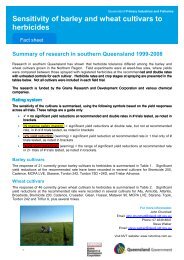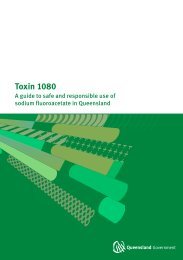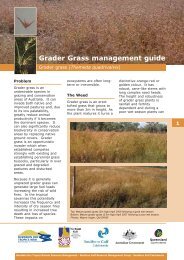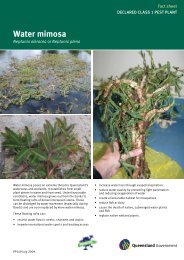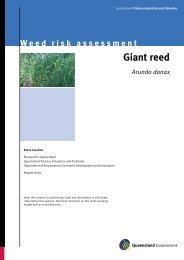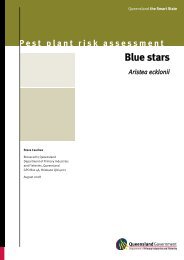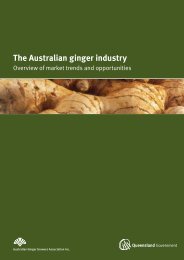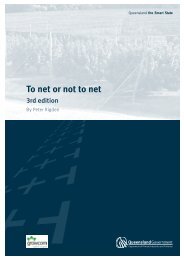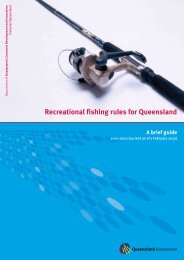Insect Control in Stored Grain - Department of Primary Industries
Insect Control in Stored Grain - Department of Primary Industries
Insect Control in Stored Grain - Department of Primary Industries
Create successful ePaper yourself
Turn your PDF publications into a flip-book with our unique Google optimized e-Paper software.
• Calibrate your application equipment with water before every use. The spray equipment must be<br />
calibrated to spray 1 litre <strong>of</strong> solution per tonne <strong>of</strong> gra<strong>in</strong>; that is, the spray rate, measured <strong>in</strong> litres per<br />
hour, must equal the auger or elevator uptake <strong>in</strong> tonnes per hour.<br />
• Wear protective cloth<strong>in</strong>g - goggles, gloves and overalls when handl<strong>in</strong>g protectants; avoid breath<strong>in</strong>g<br />
the fumes: don't eat, smoke or put your f<strong>in</strong>gers <strong>in</strong> your mouth, wash well and change your clothes<br />
when you f<strong>in</strong>ish.<br />
Mix<strong>in</strong>g amorphous silica / diatomaceous earth powder with gra<strong>in</strong><br />
Amorphous silica powder (eg., Dryacide® at www.entosol.com.au or Absorba-Cide®, or Abrade®, or<br />
Permaguard D10®) can be mixed with gra<strong>in</strong> as an alternative to the chemical sprays. It can be used on feed<br />
gra<strong>in</strong> or gra<strong>in</strong> used on the farm, but should not be used for any other gra<strong>in</strong> unless potential buyers approve<br />
<strong>of</strong> its use.<br />
The major advantages <strong>of</strong> these <strong>in</strong>ert dusts are that they leave no chemical residue, have no withhold<strong>in</strong>g<br />
period and m<strong>in</strong>imise selection for resistance. They are accepted by some organic markets. Always check<br />
with the Organic certify<strong>in</strong>g body first. (Refer to NSW DPI Organic farm<strong>in</strong>g Agfact “On-Farm Storage <strong>of</strong><br />
Organic Gra<strong>in</strong>” at www.dpi.nsw.gov.au/agriculture/farm/organic,<br />
Note: These products have some serious disadvantages for mix<strong>in</strong>g with gra<strong>in</strong>. They are far more expensive<br />
than any other chemical treatments. Bulk handlers and some buyers will not accept gra<strong>in</strong> treated with<br />
amorphous silica / diatomaceous earth because they change the handl<strong>in</strong>g characteristics <strong>of</strong> gra<strong>in</strong> and slow<br />
movement <strong>of</strong> gra<strong>in</strong> through augers.<br />
Unlike protectant chemical <strong>in</strong>secticides which are applied to gra<strong>in</strong> as a liquid spray, amorphous silica /<br />
diatomaceous earth are applied to gra<strong>in</strong> as a dust. The dust collects on <strong>in</strong>sects and dries them out. A pickle<br />
applicator or a special Dryacide® applicator, available from Dryacide Australia through rural supply houses,<br />
is the best way to apply such products.<br />
Add amorphous silica powder at the rate specified on the label. If gra<strong>in</strong> is dusty or <strong>in</strong>fested, <strong>in</strong>creas<strong>in</strong>g the<br />
application rate will <strong>in</strong>crease its effectiveness. Amorphous silica is not effective on high moisture gra<strong>in</strong> above<br />
12%.<br />
5. Fumigation - <strong>Insect</strong> control <strong>in</strong> stored gra<strong>in</strong>s with fumigation<br />
The major advantage <strong>of</strong> fumigation with phosph<strong>in</strong>e (<strong>of</strong>ten referred to as “bomb<strong>in</strong>g”, or “gas<strong>in</strong>g”, us<strong>in</strong>g eg,<br />
Fostox<strong>in</strong>, Fumitox<strong>in</strong> etc), is that <strong>in</strong>sects can be controlled without mov<strong>in</strong>g the gra<strong>in</strong>. See below for dose<br />
rates and other critical recommendations.<br />
General <strong>in</strong>formation on phosph<strong>in</strong>e fumigation<br />
Phosph<strong>in</strong>e gas moves readily through gra<strong>in</strong> from the po<strong>in</strong>t <strong>of</strong> application. Phosph<strong>in</strong>e leaks quickly through<br />
holes <strong>in</strong> silos or sheet<strong>in</strong>g. W<strong>in</strong>d and large temperature changes accelerate phosph<strong>in</strong>e loss. Most phosph<strong>in</strong>e<br />
is lost with<strong>in</strong> 4 days from fumigations <strong>in</strong> ord<strong>in</strong>ary, unsealed storages.<br />
<strong>Insect</strong>s are killed slowly by phosph<strong>in</strong>e gas. The fumigant must be kept <strong>in</strong> contact with the <strong>in</strong>sects for at<br />
least 7 days to kill all stages <strong>of</strong> the <strong>in</strong>sect’s life cycle that usually exist <strong>in</strong> stored gra<strong>in</strong>s. Fumigation <strong>in</strong><br />
ord<strong>in</strong>ary, unsealed storages will kill some adults but most eggs, larvae and pupae will survive to cont<strong>in</strong>ue<br />
the breed<strong>in</strong>g cycle. A silo that is built to be sealed gas-tight is needed to conta<strong>in</strong> sufficient phosph<strong>in</strong>e<br />
concentration for long enough to kill all stages <strong>of</strong> the <strong>in</strong>sects.<br />
Fumigation gives no residual protection to stored gra<strong>in</strong>. In other words, <strong>in</strong>sects will beg<strong>in</strong> breed<strong>in</strong>g, after the<br />
phosph<strong>in</strong>e gas concentration has dropped to low levels.<br />
Phosph<strong>in</strong>e fumigant itself leaves m<strong>in</strong>imal residues, and is acceptable to most markets. However, the solid<br />
powdery residues left by phosph<strong>in</strong>e generat<strong>in</strong>g tablets when they are mixed with the gra<strong>in</strong> are a concern to<br />
some markets. It is aga<strong>in</strong>st label recommendations to mix solid phosph<strong>in</strong>e generat<strong>in</strong>g tablets directly <strong>in</strong>to<br />
the gra<strong>in</strong>.<br />
Phosph<strong>in</strong>e is effective aga<strong>in</strong>st <strong>in</strong>sects <strong>in</strong> most types <strong>of</strong> gra<strong>in</strong>. But some commodities (for example, oilseeds<br />
– l<strong>in</strong>seed, cottonseed) soak up phosph<strong>in</strong>e very quickly, leav<strong>in</strong>g little to kill <strong>in</strong>sects.<br />
11





